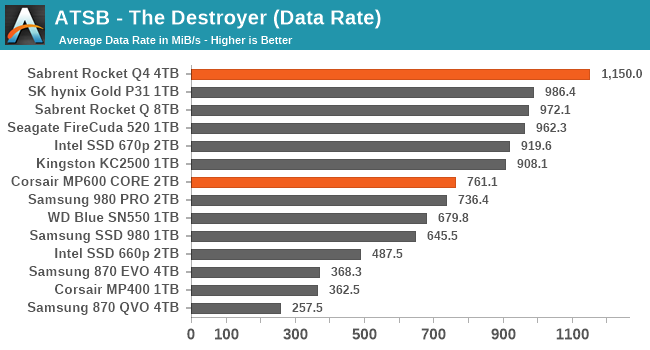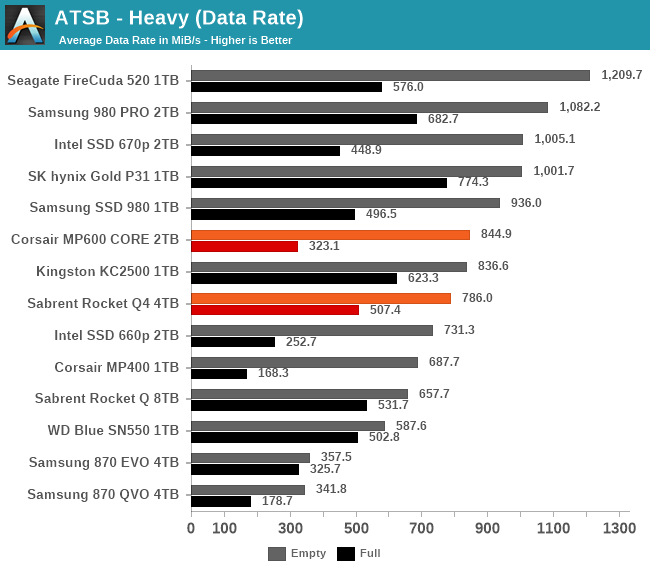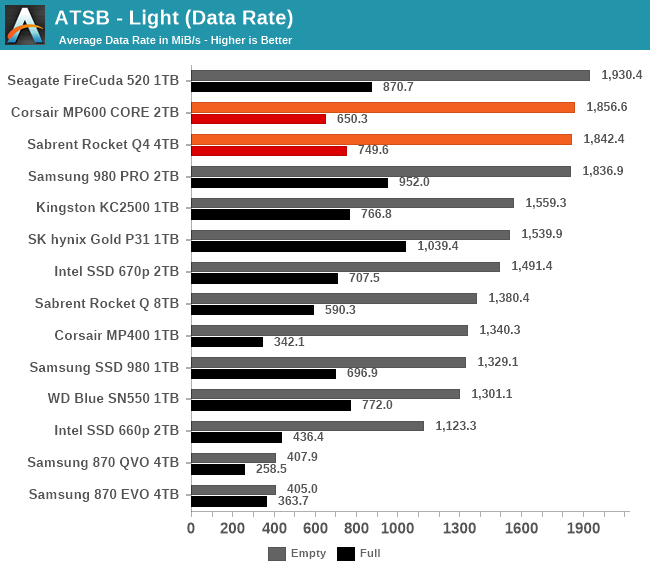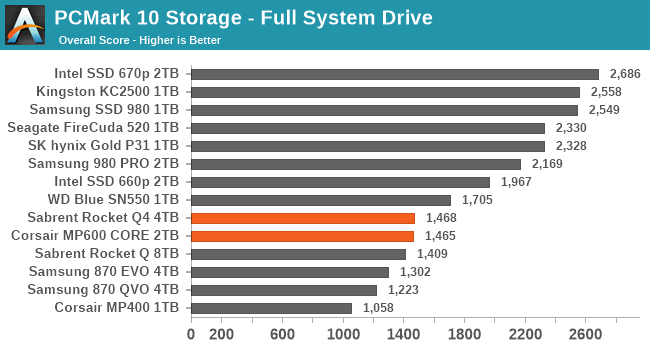Sabrent Rocket Q4 and Corsair MP600 CORE NVMe SSDs Reviewed: PCIe 4.0 with QLC
by Billy Tallis on April 9, 2021 12:45 PM ESTAnandTech Storage Bench - The Destroyer
Our AnandTech Storage Bench tests are traces (recordings) of real-world IO patterns that are replayed onto the drives under test. The Destroyer is the longest and most difficult phase of our consumer SSD test suite. For more details, please see the overview of our 2021 Consumer SSD Benchmark Suite.
 |
|||||||||
| Average Data Rate | |||||||||
| Average Latency | Average Read Latency | Average Write Latency | |||||||
| 99th Percentile Latency | 99th Percentile Read Latency | 99th Percentile Write Latency | |||||||
| Energy Usage | |||||||||
The 4TB Sabrent Rocket Q4 turns in excellent scores on The Destroyer, helped greatly by the fact that the test fits entirely within the drive's SLC cache so write latency is minimal. The 2TB Corsair MP600 CORE still has decent overall performance with solid 99th percentile latency scores indicating that it doesn't run into the kind of severe latency spikes that can be common with QLC NAND.
The major downside is that these are among the most power-hungry drives, consuming a bit more energy than the TLC-based Phison E16 drive and significantly more than any of the other drives in this batch.
AnandTech Storage Bench - Heavy
The ATSB Heavy test is much shorter overall than The Destroyer, but is still fairly write-intensive. We run this test twice: first on a mostly-empty drive, and again on a completely full drive to show the worst-case performance.
 |
|||||||||
| Average Data Rate | |||||||||
| Average Latency | Average Read Latency | Average Write Latency | |||||||
| 99th Percentile Latency | 99th Percentile Read Latency | 99th Percentile Write Latency | |||||||
| Energy Usage | |||||||||
The shorter duration of the Heavy test means that smaller drives can also get good mileage out of their SLC caches, so the 4TB Sabrent Rocket Q4 loses the advantage it had on The Destroyer. The Rocket Q4 and the Corsair MP600 CORE both turn in good scores overall for low-end drives, with clear improvement over the Phison E12 QLC drives.
However, on the full-drive test runs the 2TB MP600 CORE is showing some elevated latency. It's not as bad as on QLC SATA drives and some competing QLC NVMe drives, so overall this isn't a serious concern, but it does emphasize how QLC SSDs need a lot of capacity (and a lot of SLC cache) in order to stay close to the performance of TLC SSDs.
AnandTech Storage Bench - Light
The ATSB Light test represents ordinary everyday usage that doesn't put much strain on a SSD. Low queue depths, short bursts of IO and a short overall test duration mean this should be easy for any SSD. But running it a second time on a full drive shows how even storage-light workloads can be affected by SSD performance degradation.
 |
|||||||||
| Average Data Rate | |||||||||
| Average Latency | Average Read Latency | Average Write Latency | |||||||
| 99th Percentile Latency | 99th Percentile Read Latency | 99th Percentile Write Latency | |||||||
| Energy Usage | |||||||||
Both of the Gen4 QLC drives provide top-tier performance for the empty-drive runs of the Light test, and they also still provide acceptable performance on the full-drive test runs with no serious latency spikes. As with the other ATSB tests, they come in last place for energy efficiency.
PCMark 10 Storage Benchmarks
The PCMark 10 Storage benchmarks are IO trace based tests similar to our own ATSB tests. For more details, please see the overview of our 2021 Consumer SSD Benchmark Suite.
 |
|||||||||
| Full System Drive | Overall Score | Average Bandwidth | Average Latency | ||||||
| Quick System Drive | Overall Score | Average Bandwidth | Average Latency | ||||||
| Data Drive | Overall Score | Average Bandwidth | Average Latency | ||||||
The two PCIe Gen4 QLC drives offer good performance on the Quick System Drive and Data Drive tests, which are relatively shorter and more focused on sequential IO. The longer Full System Drive test with more random IO stresses these drives enough for their low-end nature to show through - in stark contrast to the Intel SSD 670p that manages very good scores on both of the system drive tests.










60 Comments
View All Comments
ZolaIII - Friday, April 9, 2021 - link
What's the purpose of those? I mean I recently bought MP600 1 TB for the price of MP600 Core same capacity. I didn't bought it for it's speed but it's TBW endurance which is by the way twice as MP600 Core 4GB.This doesn't have any market place in my opinion when you can buy a drive with same controller and same 96 layer but TCL NAND for a same price or just a little bit more money.
SarahKerrigan - Friday, April 9, 2021 - link
Yeah, right now really the only sweet spot for QLC is at 4TB.powerarmour - Saturday, April 10, 2021 - link
Absolutely, enough with this anti-consumer QLC junk. There needs to be a better tech solution that doesn't trade performance for density's sake, a better balance would be more ideal.Oxford Guy - Sunday, April 11, 2021 - link
'that doesn't trade performance for density's sake'Performance, value (by harming TLC's economy of scale), and longevity.
30% density increase for twice as many voltage states is not a great bargain.
ballsystemlord - Saturday, April 10, 2021 - link
A pig with lipstick on is still a pig. QLC is currently a pig.It ->still<- has huge leaps and bounds to go for before it becomes a viable SSD storage medium.
Oxford Guy - Sunday, April 11, 2021 - link
There are no leaps and bounds for it.The one thing that made TLC good enough was the transition from planar to 3D manufacturing.
QLC has no such saving grace in store – that's my bet.
arashi - Sunday, April 11, 2021 - link
4D manufacturing /s0ldman79 - Saturday, April 17, 2021 - link
With enough channels QLC and 4TB+ drives could work.SLC cache, QLC long term storage and 8-16 channels, that could work.
Honestly for longevity and performance I'm not sure QLC is going to beat out TLC unless they get QLC up to TLC's endurance and speed, which is likely not financially viable even if technically possible.
GeoffreyA - Sunday, April 11, 2021 - link
They're trying to pull the wool over people's eyes and sell margarine at the price of butter, hoping nobody notices.dickeywang - Sunday, April 11, 2021 - link
Unfortunately, the market isn't driven by consumers who can tell the difference between QLC and TLC. Most of the time, consumers just want to have larger capacity with lower prices. If it is the garbage they want, it is what they get. That's the sad story of capitalism.